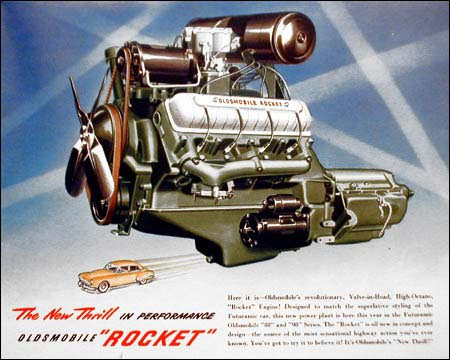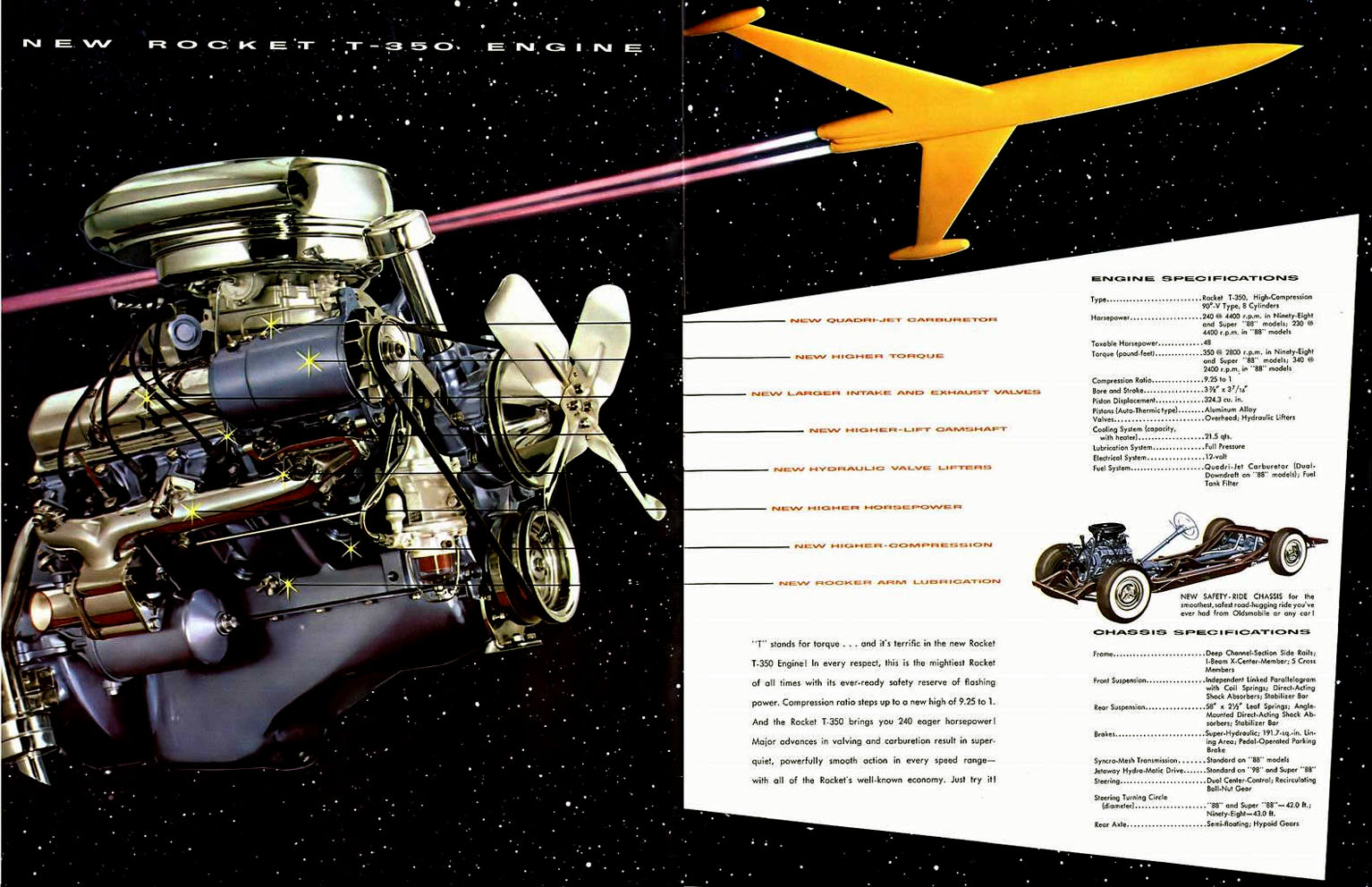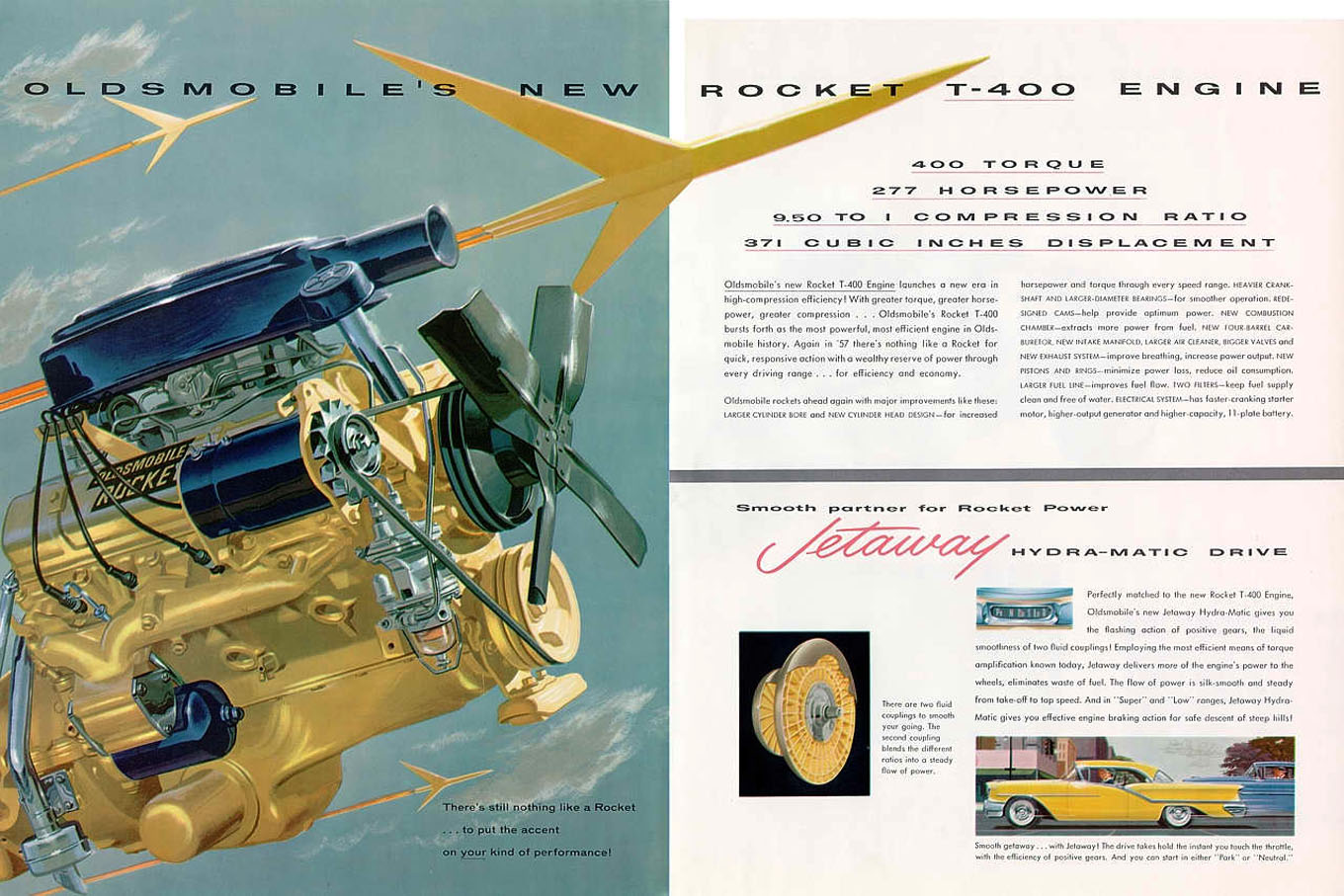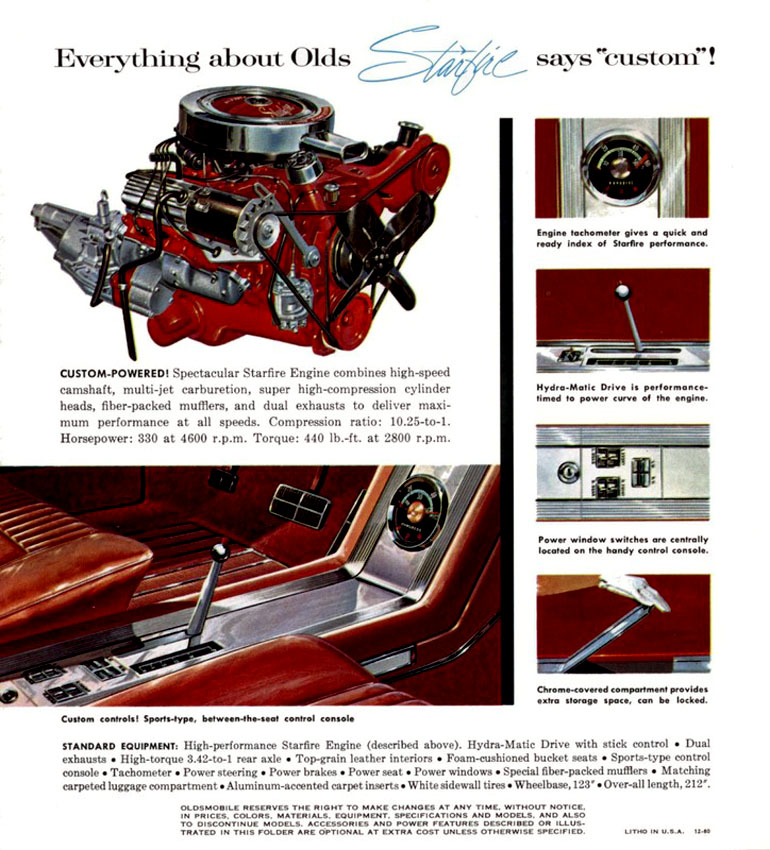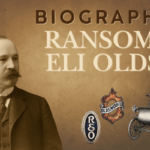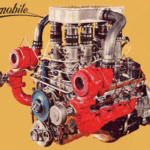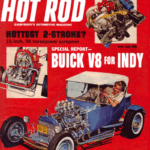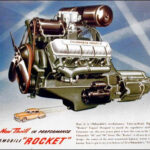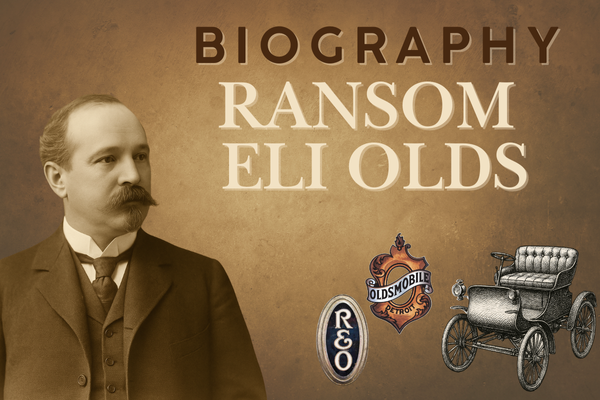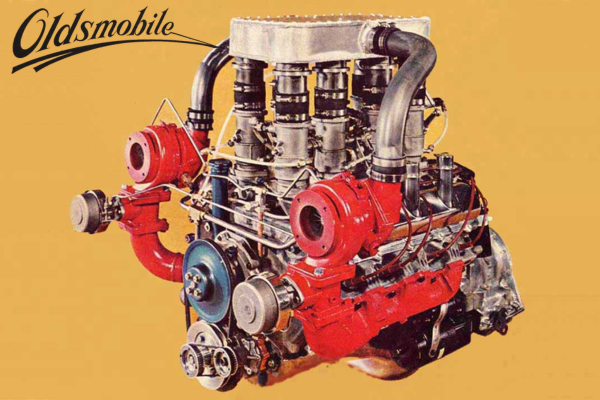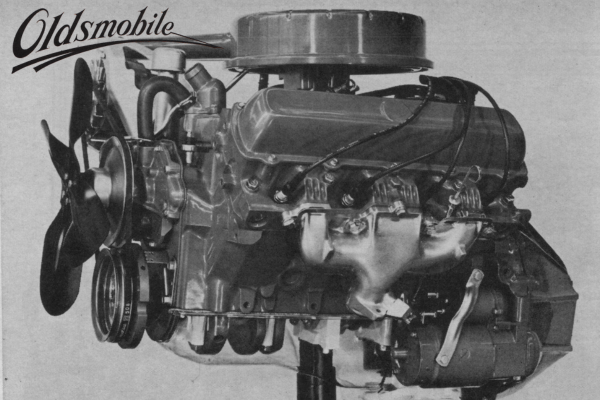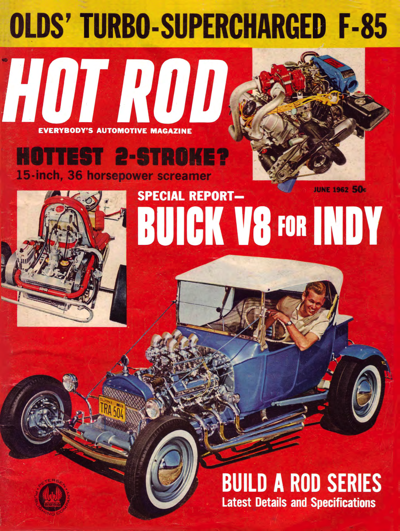The Generation One V8: from 303 to 394 Cubic Inches
The Generation One V8 Engine was introduced in 1949 and continued through 1964. Each engine in this generation is quite similar with the same design and similarly sized block and heads. Many parts and pieces are interchangeable across the entire generation.
1949 – 1953: The 303 Cubic Inch V8
The 303 cubic inch engine had hydraulic lifters, an oversquare bore:stroke ratio, a counterweighted forged crankshaft, aluminum pistons, floating wristpins, and a dual-plane intake manifold. The 303 was produced from 1949 until 1953. The engine was an oversquare design with the bore of 3.75″ and stroke of 3.4375″.
Cadillac used a similar overhead valve engine; though the Oldsmobile and Cadillac motors were not physically related, many lessons learned by one division were incorporated into the other’s design, and the result were two engines known for their excellent power-to-weight ratio, fuel economy, and smooth, strong, reliable running.
The original 303 Oldsmobile V8 was originally to be advertised as “Kettering Power” after chief engineer Charles Kettering, but company policy disallowed the use of his name. So the engine was sold as the “Oldsmobile Rocket”. The engine was available in Oldsmobile’s 88 and Super 88 models, which acquired the nickname “Rocket 88”.
From 1949 through 1951, the “88” 303’s came with a 2-barrel carburetor. It made 135 hp and 253 lbs. ft. of torque. 1952 88 and Super 88 V8s used a 4-barrel carburetor for 160 hp and 265 lbs. ft. of torque. 1953 versions upped the compression from 7.5:1 to 8.0:1 for 165 hp and 275 lbs. ft. of torque. In comparison, the famous 1949 Ford “Flathead” V8 produced just 100 hp.
The 303 V8 was used in the following vehicles: 1949-1953 Oldsmobile 88, 1952-1953 Oldsmobile Super 88, and 1949-1953 Oldsmobile 98.
1954 – 1956: 324 Cubic Inch V8
The 324 cubic inch version of the Olds V8 was produced from 1954 until 1956. Bore was increased to 3.875″ and stroke remained the same at 3.4375″. All high performance 324s came with 4-barrel carburetors. Surprisingly, the 324 was used by GMC trucks of the period for their V8 engine option.
The 1954 88 V8s used an 8.25:1 compression ratio and a 2-barrel carburetor to achieve 170 hp and and 295 lbs.ft. of torque. Super 88s reached 185 hp and 300 lbs. ft. via a 4 barrel carb. The 1955 upped the compression to 8.5:1 to reach 185 hp and 320 lbs. ft. of torque in the 2-barrel 88 and 202 hp and 332 lbs. ft. in the Super 88 and 98.
Compression was up to 8.5:1 in the 1956 88. This change brought the engine to 230 hp and 340 lbs. ft. At 8.75:1 the Super 88 and 98 reached 240 hp and 350 lbs. ft of torque.
The 324 V8 was used in the following vehicles: 1954-1956 Oldsmobile 88, 1954-1956 Oldsmobile Super 88, and 1954-1956 Oldsmobile 98.
1957 – 1963: 371 Cubic Inch V8
371s were produced from 1957 through 1963. Bore was now 4.0″ and stroke was increased to 3.6875″ for 371 cubic inches. 1957 and 1958 engines used gold painted block and valve covers, while 1959 and 1960 371s used green painted block and valve covers. 4-barrel models had 9.25:1 compression in 1957 and 10:1 in 1958.
The 1957 model was rated at 277 hp and 400 lbs. ft. of torque. and the ’58 pumped out 305 hp and 410 lbs. lbs. ft. The 1958 2-barrel version produced a respectable 265 hp and 390 lbs. ft. With the introduction of the 394 (see next section) the 371 became the “economy” engine for use in the 88, and a less aggressive camshaft and lower compreession pistons were used, thus, power for the 1959 and 1960 88 model was a conservative 270 hp and 390 lbs. ft. for 1959 and an even lower 240 hp and 375 lbs. ft. for 1960.
The 371 2 bbl. was also used in GMC trucks. In GMC usage, it was called a “370” and received GMC branding, with no hint of its Olldsmoble heritage.
The 371 V8 was used in the following vehicles: 1957-1960 Oldsmobile 88, 1957-1958 Oldsmobile Super 88, and 1957-1958 Oldsmobile 98
1957 – 1958: 371 J-2 Golden Rocket and J-2R Super Golden Rocket V8s
The 1957 and 1958 J-2 option was named “Golden Rocket”. It was a true high performance engine with three two-barrel carburetors. The secondary carbs operated with a vacuum-linkage. Only the center carburetor was mechanically connected to the throttle, and it was the only one equipped with a choke. When the center carburetor was opened to 60 degrees or more, engine vacuum drawn from the windshield wiper pump would simultaneously open the front and rear carburetors. because of the vacuum operation, the outer carburetors did not open progressively; they were either open or closed.
This system worked OK with the Hydramatic transmission, as it would similtaneously “kick down” to a lower gear, for either passing or acceration from a standing start, but it was clumsy in standard transmission applications. Many J2 engines were converted to non-vacuum mechanical progressive linkage, using aftermarket parts – especially the J2-R.
The J-2 engine had a slightly thinner head gasketthan the standard 371 4barrel, raising compression to 10.0:1. It was advertised with gross power and torque ratings of 312 hp @ 4600 rpm and 415 lbs. ft of torque @ 2800 rpm.
Oldsmobile charged $83 for the J-2 option. In practice, owners who did not regularly drive hard enough to engage the front and rear carburetors experienced problems with the linkage and carburetor throats becoming clogged. Oldsmobile discontinued the J-2 after 1958.
Oldsmobile offered a “R” version with a very long duration and higher lift camshaft, requiring special dimples in the valve covers so that the rockers woud not bind (a rare , highly sought after piece). These engines were to be the “killer” engine in NASCAR, where Olds was very active, but the AMA racing ban relegated the stock of these engines to drag racers, where even in the heavy 88 the car made a good showing. Based upon the times which the car achieved in the quarter mile, it was estimated that the J-2 R made close to 370 hp, or the magic one horse per cube milestone.
1959 – 1964: the 394 Cubic Inch V8
Introduced in 1959, the 304 was the largest first-generation Rocket engine. To reach 394 cubic inches, Oldsmobile increased the bore to 4.125″. 394s were produced from 1959 through 1964. The 394 replaced the 371 in Super 88 and 98 cars for 1959 and 1960 and a detuned 2 barrel carburetor version was used in the 88, beginning in 1961 and in the Dynamic 88 for 1962 through 1964.
The 4-barrel version was called the “Sky Rocket” in1961 through 1963 and “Rocket” in 1964 For 1961 the compression was 10.0:1, It produced 325 hp and had 435 lbs. ft of torque, while the 1962-1964 version had 10.25:1. This upped power to 330 hp and 440 lbs. ft. A special 1963 10.5:1 version was also produced for the Starfire and Police engines with 345 hp.
Four barrel carbureted 394 engines were painted red, and two barrel 394 engines were painted green.
The 394 V8 was used in the following vehicles:
- 1959-1960 Oldsmobile Super 88, 315 hp and 435 lbs. ft of torque.
- 1959-1960 Oldsmobile 98, 315 hp and 435 lbs. ft.
- 1961 Oldsmobile 88, 250 hp and 405 lbs. ft.
- 1962-1964 Oldsmobile Dynamic 88, 280 hp and 430 lbs. ft.
- 1964 Oldsmobile Jetstar I, 345 hp and 440 lbs. ft.
- 1961-1963 Oldsmobile Dynamic 88 4-barrel option, 325 hp and had 435 lbs. ft.
- 1961-1964 Oldsmobile Super 88 (standard); 1961-1964 Oldsmobile 98 (standard): 330 hp and 440 lbs. ft.
- 1964 Starfire, Police and 98 Custom-Sports Coupe (also optional in all 98s and Super 88s) 345 hp and 440 lbs. ft.


